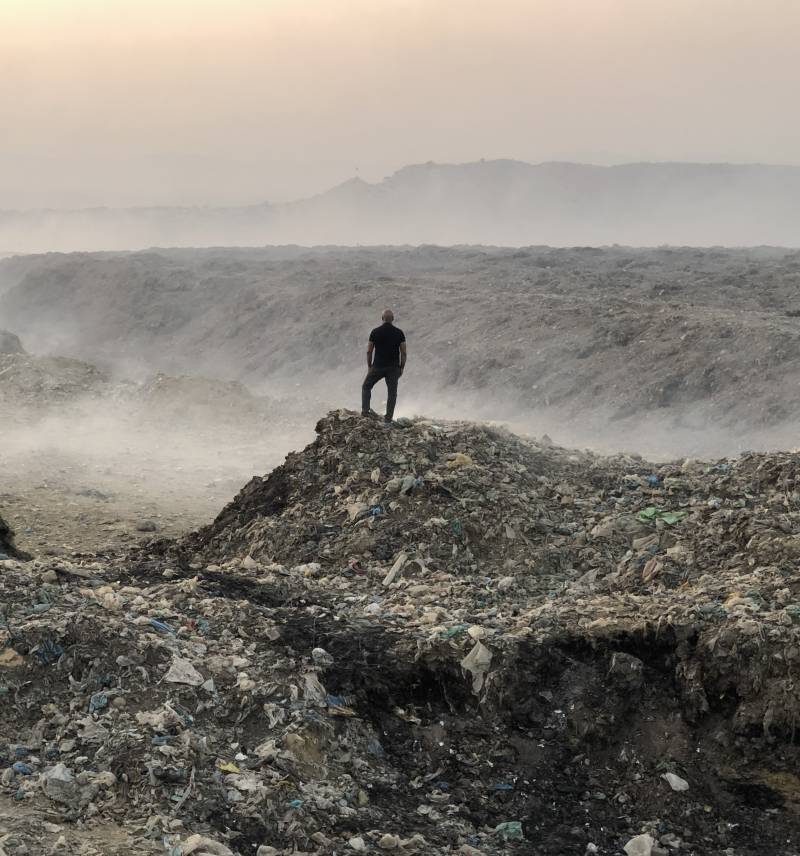
At the opening of the second edition of Karachi Biennale, a jury comprising of local and foreign members announced Rashid Rana’s art installation as the best work in the mega exhibition. This edition of the Karachi Biennale features work by local and international artists displayed at 7 different venues all over the cosmopolitan city of Karachi.
The installation unfolds in two parts; a video projection and a photo montage. In the performative video, Rashid Rana evokes reference to the iconic painting Wanderer above the Sea of Fog by Caspar David Friedrich. Here, Rana stands amidst one of the largest garbage dumping sites in Pakistan called Kachra Khundi (located near village Jam Chakro about 20 kilometers away from the main city of Karachi). The structure of the work reminds of a painting from the past but it also evokes our own reality – one of being exposed to hazardous heaps of waste, especially in the port city of Karachi.
In the second part of the installation, viewers come across a photo montage that appears to be a seascape from a distance but on closer inspection reveals images of trash and waste plastic bags in great numbers, giving the illusion of sea waves with pictures of sailing ships inserted within. This may best be seen as a commentary on colonialism and then consumerism, which produced affluence (as well as “refuse”) far beyond human need or control.
Widely considered to be one of the leading artists working in South Asia today, Rashid Rana emerged in the early years of this century as the most energetic and productive representative of an entirely new kind of art from Pakistan. He has shown extensively at various at various galleries and museums in Pakistan and abroad. His works are in prestigious collections such as the British Museum London, the Metropolitan Museum in New York and Fukuoka Museum in Japan. He is the founding faculty member and currently Dean of the School of Visual Arts and Design at the Beaconhouse National University, Lahore. Rana is a recipient of the 2017 Asia Art Award presented by the Asia Society, and was awarded International Artist of the Year by South Asian Visual Arts Collective(SVAC) Canada in 2003.
The installation unfolds in two parts; a video projection and a photo montage. In the performative video, Rashid Rana evokes reference to the iconic painting Wanderer above the Sea of Fog by Caspar David Friedrich. Here, Rana stands amidst one of the largest garbage dumping sites in Pakistan called Kachra Khundi (located near village Jam Chakro about 20 kilometers away from the main city of Karachi). The structure of the work reminds of a painting from the past but it also evokes our own reality – one of being exposed to hazardous heaps of waste, especially in the port city of Karachi.
In the second part of the installation, viewers come across a photo montage that appears to be a seascape from a distance but on closer inspection reveals images of trash and waste plastic bags in great numbers, giving the illusion of sea waves with pictures of sailing ships inserted within. This may best be seen as a commentary on colonialism and then consumerism, which produced affluence (as well as “refuse”) far beyond human need or control.
Widely considered to be one of the leading artists working in South Asia today, Rashid Rana emerged in the early years of this century as the most energetic and productive representative of an entirely new kind of art from Pakistan. He has shown extensively at various at various galleries and museums in Pakistan and abroad. His works are in prestigious collections such as the British Museum London, the Metropolitan Museum in New York and Fukuoka Museum in Japan. He is the founding faculty member and currently Dean of the School of Visual Arts and Design at the Beaconhouse National University, Lahore. Rana is a recipient of the 2017 Asia Art Award presented by the Asia Society, and was awarded International Artist of the Year by South Asian Visual Arts Collective(SVAC) Canada in 2003.
